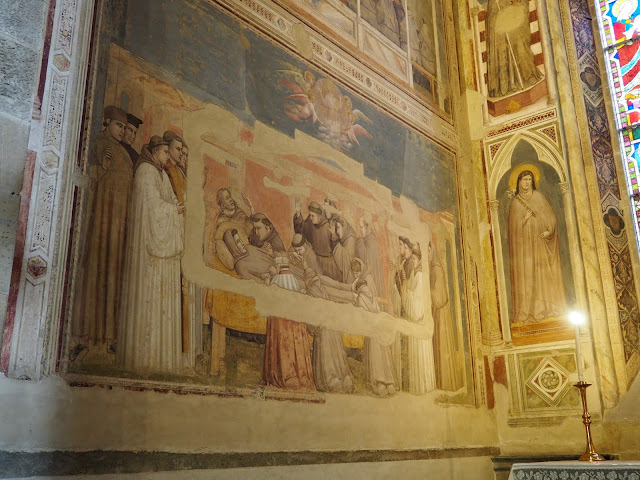【フィレンツェ】サンタ・クローチェ教会 ジョット Firenze - Santa Croce, Giotto
サンタ・クローチェ教会には、ジョットのフレスコ画が描かれている。
現在では、中央の礼拝堂のすぐ右手のバルディ家の礼拝堂、そしてさらにその右手のペルッツィ家の礼拝堂にジョットの絵がある。
ジョルジュ・ヴァザーリの『芸術家列伝』によれば、かつては4つの礼拝堂に描かれていたというが、現在残っているのはこの2つだけだ。
バルディ家の礼拝堂には、『聖フランチェスコ伝』が描かれている。
このサンタ・クローチェ教会は、聖フランシスコ派に属しているので、テーマとしてはとてもふさわしい。
聖フランチェスコが亡くなる場面では、その死を悲しむ人々の様々な表情や仕草が感情豊かに描かれている。
ジョットが生きた時代は、まだビザンティン様式の無表情でやや形式的な絵画が主流だったが、ジョットは絵画に人間の自然な表情や、自然のありのままの風景を描いて、その後のヨーロッパの絵画史に大きな影響を与えた。
Giotto's frescoes are painted in the church of Santa Croce.
Today, there is a picture of Giotto in the Bardi chapel just to the right of the central chapel, and in the Peruzzi chapel to the right.
According to Giorgio Vasari, he was once depicted in four chapels, but only these two are left today.
The "Saint Francis of Assisi" is depicted in the chapel of the Bardi family.
This church of Santa Croce belongs to the St. Franciscans, so it is a very suitable theme.
In the scene where St. Francis died, the various facial expressions and gestures of those who mourn his death are emotionally depicted.
In the days when Giotto lived, Byzantine-style expressionless and somewhat formal paintings were still the mainstream, but Giotto painted natural human facial expressions and natural landscapes, and then European paintings. It had a great influence on history.
隣のペルッツィ家の礼拝堂には、『洗礼者ヨハネ伝』が描かれている。
こちらは、『聖フランチェスコ伝』とは違った手法で描かれたためか、保存状態はあまり良くなくて、人々の細かい表情などを見ることはできない。
ジョットは、このサンタ・クローチェ教会での制作を終えた後で、アッシジの聖フランチェスコ教会に、壮大な聖フランチェスコの生涯を描いた。
In the chapel of the Peruzzi family next door, "John the Baptist" is drawn.
This is probably because it was drawn in a different way from "Saint Francis of Assisi", and it is not well preserved, so you cannot see the detailed facial expressions of people.
After finishing his work at the church of Santa Croce, Giotto painted the magnificent life of St. Francis in Assisi's church of St. Francis.
ジョットは、1267年ごろに生まれたと言われている。ヴァザーリによれば、フィレンツェ近郊の農村に生まれた、チマブーエに見出されて、フィレンツェで彼の元で絵の修行をしたとのことだが、これらはどうも事実ではないようだ。
ジョットはダンテと同時代の人物だった。
ダンテの『神曲』の中でもジョットの名前が登場する。
ダンテは煉獄編の中で、かつてはチマブーエの絵がもてはやされたが、現在ではジョットの方が評価が高い、と表現している。
Giotto is said to have been born around 1267. According to Vasari, he was found in Cimabue, a rural village near Florence, and practiced painting under him in Florence, but these do not seem to be true.
Giotto was a contemporary of Dante.
Giotto's name appears in Dante's Divine Comedy.
In the Purgatory edition, Dante once touted the painting of Cimabue, but now Giotto is more highly regarded.
(Translated by Google Translate)





コメント
コメントを投稿